EDIT: Thanks for the clarification. I have changed the answer.
It is important to realize that you are trying to project a selection in multi-dimensional space into a 1D space. Not in every case you will be able to see a clear separation like the one you got. There are also various possibilities to do that, here I made a simple example that could help your client to interpret the model, but does not represent the full complexity of the model, of course.
You did not provide any sample data, so I will generate some from the breast cancer dataset.
First let's import what we need:
from sklearn import datasets
from xgboost import XGBClassifier
import pandas as pd
import numpy as np
And now import the dataset and train a very simple XGBoost Model
cancer = datasets.load_breast_cancer()
X = cancer.data
y = cancer.target
xgb_model = XGBClassifier(n_estimators=5,
objective="binary:logistic",
random_state=42)
xgb_model.fit(X, y)
y_prob = pd.DataFrame(xgb_model.predict_proba(X))[0]
There are multiple ways to solve this.
One approach is to bin in the probability given by the model. So you will decide which probabilities you consider to be "High Risk", "Medium Risk" and "Low Risk" and the intervals on data can be classified. In this example I considered low to be 0 <= p <= 0.5, medium for 0.5 < p <= 0.8 and high for 0.8 < p <= 1.
First you have to calculate the probability for each prediction. I would suggest to maybe use the test set for that, to avoid bias from a possible model overfitting.
y_prob = pd.DataFrame(xgb_model.predict_proba(X))[0]
df = pd.DataFrame(X, columns=cancer.feature_names)
# Stores the probability of a malignant cancer
df['probability'] = y_prob
Then you have to bin your data and calculate average probabilities for each of those bins. I would suggest to bin your data using np.histogram_bin_edges automatic calculation:
def calculate_mean_prob(feat):
"""Calculates mean probability for a feature value, binning it."""
# Bins from the automatic rules from numpy, check docs for details
bins = np.histogram_bin_edges(df[feat], bins='auto')
binned_values = pd.cut(df[feat], bins)
return df['probability'].groupby(binned_values).mean()
Now you can classify each bin following what you would consider to be a low/medium/high probability:
def classify_probability(prob, medium=0.5, high=0.8, fillna_method= 'ffill'):
"""Classify the output of each bin into a risk group,
according to the probability.
Following the follow rules:
0 <= p <= medium: Low risk
medium < p <= high: Medium risk
high < p <= 1: High Risk
If a bin has no entries, it will be filled using fillna with the method
specified in fillna_method
"""
risk = pd.cut(prob, [0., medium, high, 1.0], include_lowest=True,
labels=['Low Risk', 'Medium Risk', 'High Risk'])
risk.fillna(method=fillna_method, inplace=True)
return risk
This will return you the risk for each bin that you divided your data. Since you will probably have multiple bins that have consecutive values, you might want to merge the consecutive pd.Interval bins. The code for that is shown below:
def sum_interval(i1, i2):
if i2 is None:
return None
if i1.right == i2.left:
return pd.Interval(i1.left, i2.right)
return None
def sum_intervals(args):
"""Given a list of pd.Intervals,
returns a list summing consecutive intervals."""
result = list()
current_interval = args[0]
for next_interval in list(args[1:]) + [None]:
# Try to sum the current interval and nex interval
# The None in necessary for the last interval
sum_int = sum_interval(current_interval, next_interval)
if sum_int is not None:
# Update the current_interval in case if it is
# possible to sum
current_interval = sum_int
else:
# Otherwise tries to start a new interval
result.append(current_interval)
current_interval = next_interval
if len(result) == 1:
return result[0]
return result
def combine_bins(df):
# Group them by label
grouped = df.groupby(df).apply(lambda x: sorted(list(x.index)))
# Sum each category in intervals, if consecutive
merged_intervals = grouped.apply(sum_intervals)
return merged_intervals
Now you can combine all the functions to calculate the bins for each feature:
def generate_risk_class(feature, medium=0.5, high=0.8):
mean_prob = calculate_mean_prob(feature)
classification = classify_probability(mean_prob, medium=medium, high=high)
merged_bins = combine_bins(classification)
return merged_bins
For example, generate_risk_class('worst radius') results in:
Low Risk (7.93, 17.3]
Medium Risk (17.3, 18.639]
High Risk (18.639, 36.04]
But in case you get features which are not so good discriminators (or that do not separate the high/low risk linearly), you will have more complicated regions. For example generate_risk_class('mean symmetry') results in:
Low Risk [(0.114, 0.209], (0.241, 0.249], (0.272, 0.288]]
Medium Risk [(0.209, 0.225], (0.233, 0.241], (0.249, 0.264]]
High Risk [(0.225, 0.233], (0.264, 0.272], (0.288, 0.304]]
